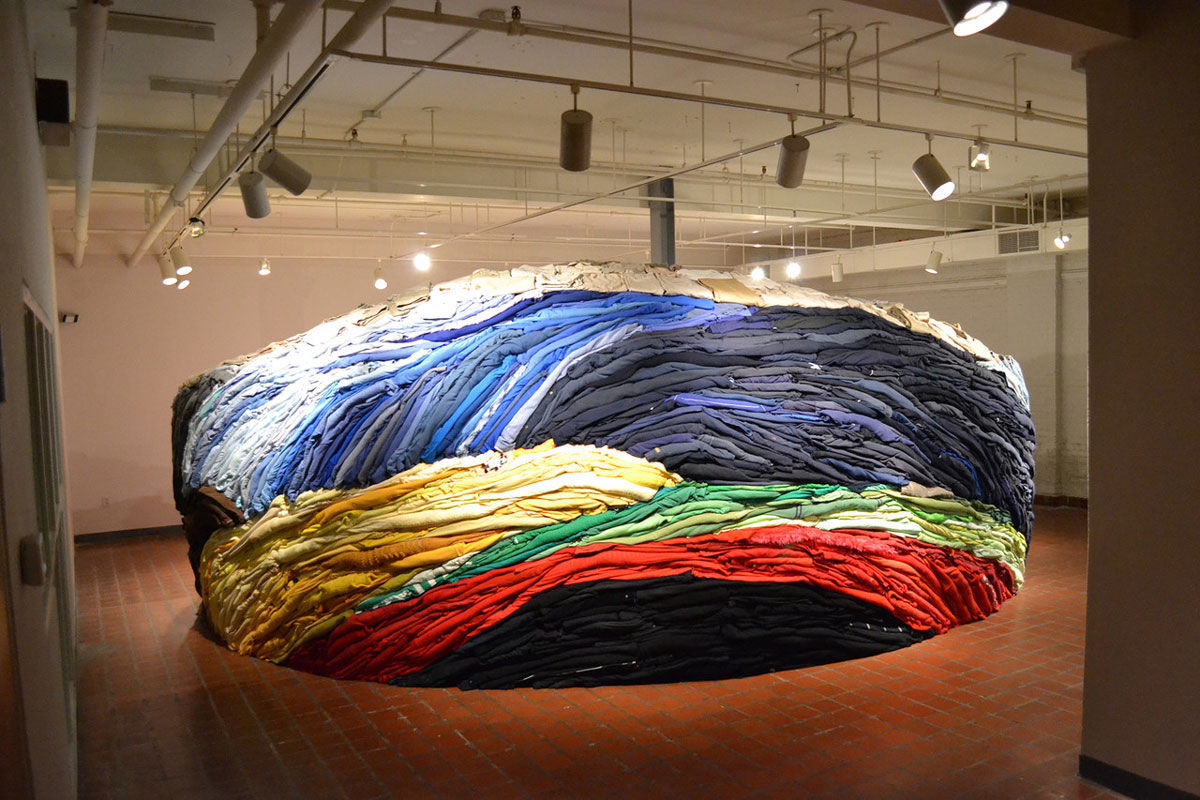Using recycled materials, Jarod Charzewski’s site-specific installation targets consumerism

Jarod Charzewski is the South Carolina Arts Commission’s 2016 Visual Arts Fellow. Applications for the next round of Fellowships are due November 1.
From The Free Times
Article by August Krickel
Soil is on view Oct. 27 – Dec. 8 at USC’s McMaster Gallery, 1615 Senate St., Columbia. Opening reception: Oct. 27 from 5 – 7 p.m.
Image above: Jarod Charzewski’s Scarp
Artist Jarod Charzewski sits on a pile of lumber in the University of South Carolina’s McMaster Gallery. Next to him is a larger mound of salvaged inner tubes and bicycle tires. Over the next six days, Charzewski, an associate professor of sculpture at the College of Charleston, will use these materials to create a site-specific installation for his solo exhibition Soil.
He hopes to make a statement on contemporary consumer culture and on what he describes as the abundant “quantity of wasted materials, and the unsustainability of consumer practice.”
“Something really struck me when I was very young,” Charzewski recalls, “when I found out that my elementary school was built on a landfill site, and that immediately grabbed a hold of my imagination. I thought of being able to cut open the earth and look at layers of trash. Throughout my career, I’ve built these different kinds of landscapes out of different things. It’s about being able to round up large quantities of materials, and it’s astonishingly easy to accumulate these things, and that becomes part of the piece.”
He’s done similar work before, but never with inner tubes. His installation Scarp opened at the College of Charleston in 2008, consisting of some 5,000 articles of clothing, borrowed from — and later returned to — Goodwill. A wooden and cardboard framework fixed the garments in multicolored layers, suggesting geological formations, much as he plans for Soil.
In an artist’s statement for the Columbia installation Charzewski says “the materials will be organized and positioned neatly in the gallery to create the appearance of sedimentary layers of earth. This aesthetic will reference the transitional Columbia, South Carolina, landscape, as it is located on the cusp of the Lowcountry and the Appalachian Mountains. All materials will be recycled after the exhibition closes.”
Charzewski describes how he will build a detailed and calculated framework with the lumber, stretching the tires and tubes on top of it.
He anticipates “a lot of experimentation and figuring it out — that’s something I teach my students all the time. You can’t Google how to do this. You have to think quickly and be resourceful. … I get into the site, and feel it out, and see what I need to do.”
Named by the South Carolina Arts Commission as 2016’s Visual Arts Fellow, Charzewski has several permanent installations in restaurants and corporate lobbies in Charleston and is working on a permanent outdoor piece for the Blythewood branch of the Richland Library.
McMaster Gallery Director Shannon Lindsey says that the themes in Charzewski’s work appealed to the gallery’s selection committee, which reviewed some 150 submissions after a call for artists for the current season.
“We were looking for interdisciplinary artists who may not define themselves through one particular craft or medium, or that could really appeal to all the facets that we offer here in the School of Visual Art and Design,” she says.
Charzewski’s proposed project presented unique challenges. Unlike a painter, he couldn’t simply unload finished work and hang it. Instead, he must physically be in the space before beginning work. Art students will help with the construction, and the artist will give lectures to classes in the School of Earth, Ocean and Environment.
For Charzewski, the environment has always been an influence. Raised in Manitoba, Canada, the artist says that “it’s hard to grow up in the prairies without thinking about wide, open spaces, and that sense of the infinite. Any place you grow up informs who you are, your psychology, and your makeup, and that has always translated into my work.”

